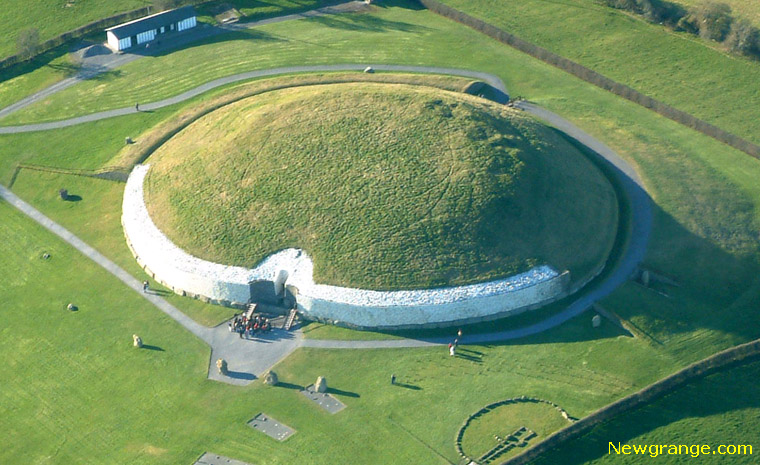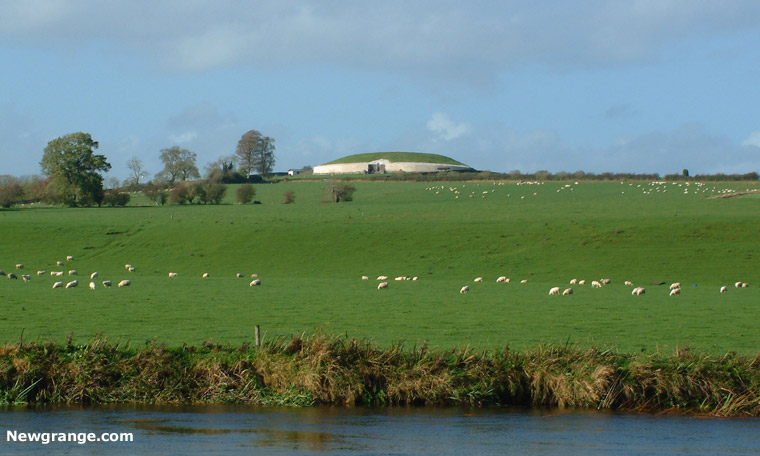Brú na Bóinne - A Sustainability Study
By Bettina Graham - Full Paper in PDF format (700 KB)Introduction
‘It’s hardly surprising that the authorities have been unable to resist the temptation to open the place up as a heritage money-spinner: as you approach the tomb, a roadside protest placard announces: “Newgrange to close after 5000 years. Disneygrange opening soon.” (Greenwood & Hawkins 1997)’.Heritage tourism in Ireland has been increasing over recent years, with a 5.23% increase in 2006. It is imperative to keep the balance between satisfying the tourists’ expectations and simultaneously sustaining the actual heritage site.
This essay will examine the World Heritage Site of Brú na Bóinne in County Meath, Ireland, with regard to its stakeholders and some aspects of environmental and social sustainability. It is hoped that this paper can highlight the complexity of the sustainability issues with regard to a World Heritage Site.
Due to the fragmented heritage management system in Ireland, the author experienced difficulty in obtaining information regarding this heritage site. There is no centralised website available. The research conducted bases its findings on the Brú na Bóinne Development Plan 2000, the Meath County Council Development Plan 2007-2013 and information available on the internet.
Sustainability Definition
Before looking into the issues of sustainability relating to a tourist attraction and its development, an understanding of the meaning of sustainability is required.Bord Failte'a draft development plan 1993-1997 acknowledges the limitations to the growth of heritage sites, the importance of the conservation of the authentic base rather than the packaging. Furthermore it supports the intrinsic importance of the attraction itself rather than facilities designed around them. It strives to obtain higher returns in the industry through quality rather than numbers (Meldon in Kockel 1994).
Sustainability means ‘economically viable, but does not destroy the resources on which the future of tourism will depend, notably the physical environment, and the social fabric of the host community’ (Swarbrooke 1999 cited by Ritchie & Crouch 2003).
Sustainable development is defined as ‘a policy for continued economic and social development without detriment to the environment and the natural resources on the quality of which continued human activity and further development depend’ (Commission of the European Communities 1992, cited by Meldon in Kockel 1994).
It can therefore be concluded that sustainability for a tourist attraction concerns the development and exploitation of the natural and/or built resource(s) without destroying the site for future generations while respecting and implementing the stakeholders’ inputs and values.
Brú na Bóinne
Brú na Bóinne, meaning ‘mansion on the Boyne’ is the name given to the Visitor Centre that provides access to the Newgrange and Knowth neolithic passage tombs (Duffy 2006). These tombs have been built around 3250BC, 500 years before the Pyramids of Egypt and 1000 years before Stonehenge. They are therefore the oldest existing building in the world (Clarke, Walfare and Fairly 1980). Discovered by accident in 1699 by the then landowner Mr. Campbell, Newgrange was excavated and restored by Professor O’Kelly between 1962-1975 on behalf of and financially supported by Fáilte Ireland (Kearns 2005).The Knowth passage tomb was discovered in 1967/68 by Professor George Eogan. The latter shows continuous human activity, dating further back than Newgrange until the Middle Ages (Duffy 2006). This tomb is not accessible to the public. In 1993 the area was listed as a World Heritage Site by the United Nations Educational, Scientific and Cultural Organization (UNESCO 2007). The entire site comprises 93 recorded monuments (Meath County Council 2007a). The new visitor centre, Brú na Bóinne, was opened in 1997 just South of the tombs on the far side of the river Boyne and is now the only entrance to the Knowth and Newgrange tombs.
It is believed that Newgrange is built as a burial site as well as an astronomic calendar (Kearns 2005). At the winter solstice on the 21st of December each year (and a few days either side of this date), the rays of the raising morning sun fall through a small opening in the roof box of the mound illuminating the burial chamber situated 19m inside the tomb for about 17 minutes (Kearns 2005).
Facilities at the visitor centre include a tourist information office, audio-visual presentations of Newgrange and the Boyne Valley, a gift shop, a wheelchair accessible replica of the Newgrange tomb (Duchas 2002), leaflets in seven languages, a tearoom with seating for 110 visitors, car and bus parking and toilets (Heritage Ireland 2007).
A paper by Bettina Graham - Completed in October 2007 as part of the requirement for ‘Destinations in Tourism Systems’ in the post-graduate Certificate of Tourism Management at the University of Technology Sydney - Faculty of Business in the School of Sport, Leisure and Tourism.
Full Paper in PDF format (700 KB)
Boyne Valley Private Day Tour
 Immerse yourself in the rich heritage and culture of the Boyne Valley with our full-day private tours.
Visit Newgrange World Heritage site, explore the Hill of Slane, where Saint Patrick famously lit the Paschal fire.
Discover the Hill of Tara, the ancient seat of power for the High Kings of Ireland.
Book Now
Immerse yourself in the rich heritage and culture of the Boyne Valley with our full-day private tours.
Visit Newgrange World Heritage site, explore the Hill of Slane, where Saint Patrick famously lit the Paschal fire.
Discover the Hill of Tara, the ancient seat of power for the High Kings of Ireland.
Book Now
Home
| Visitor Centre
| Tours
| Winter Solstice
| Solstice Lottery
| Images
| Local Area
| News
| Knowth
| Dowth
| Articles
| Art
| Books
| Directions
| Accommodation
| Contact


